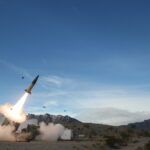Preventing space war
By John L. Remo | January 7, 2009
To initiate war in space is to invite disaster. Namely, the destruction of orbital assets such as satellites (whether military or civilian) could create an orbital debris collision chain reaction so damaging that it would make space useless for the foreseeable future. Not to mention that space debris, some of it toxic, could rain down on Earth for centuries. Even limited aggressive acts that destroy satellites are perilous calculated risks initiated by those who do not understand the dynamic low-gravity environment of near Earth space.
Therefore, for the benefit of all, the “commons of space” must be preserved and declared off-limits to active warfare that generates orbital debris either directly or indirectly. And we must proceed now. As while no state officially plans to introduce space weapons, judging by antisatellite-related research programs in the European Union, India, and specifically, recent and past antisatellite (ASAT) activities by China, the United States, and the Russian Federation, it would be unwise to assume this will remain the case in the future. And again, it cannot be underscored enough that space warfare isn’t a small evolutionary step beyond strategic Earth-based warfare but a potentially cataclysmic and irreversible step backward.
In terms of current international treaties and agreements protecting and governing space, there are the 1967 Treaty on Principles Governing the Activities of States in the Exploration and Use of Outer Space (commonly referred to as the U.N. Outer Space Treaty); the 1972 Convention on International Liability for Damage Caused by Space Objects; and the 1976 Convention on Registration of Objects Launched into Outer Space. These treaties have established a template for the structure of further outer space agreements that could be ratified by member states. There is also the 1984 Agreement Governing the Activities of States on the Moon and Other Celestial Bodies, which unfortunately has been signed by only a few member states and has only minimal force. While none of these agreements directly address the issues of space warfare and space weapons, they presume the need for a peaceful, weapons-free near-Earth space environment.
The intent of these agreements is supported by the activities of the U.N. Committee on the Peaceful Uses of Outer Space and its secretariat, the U.N. Office of Outer Space Affairs. These organizations entertain all possible measures to maintain outer space for peaceful applications and utility; they cannot, however, address either passive or active military applications because the United Nations is tasked with addressing exclusively peaceful uses of space and doesn’t have specific jurisdiction over near-Earth space issues. This can only be corrected by international action motivated by mutual advantage.
Such collective action, of course, needs a framework to operate within. On this count, the international community should look to the 1972 Anti-Ballistic Missile (ABM) Treaty between the United States and Soviet Union when devising ways in which to keep space free of weapons. A Cold War initiative, the ABM Treaty diminished the likelihood of strategic nuclear war by prohibiting the deployment of full-scale missile defense systems. So since neither the United States nor the Soviet Union were assured a first-strike capability without the risk of effective retaliation, undertaking such an attack would have been unacceptable, i.e., the mutually assured destruction concept. (As a side note, the United States unilaterally withdrew from the treaty in June 2002, leading to the current U.S.-Russian imbroglio over U.S. missile defense installations in Eastern Europe.)
It’s easy to see how a similar treaty would work in space: With space weapons outlawed, there can be no space-based weapons to initiate space warfare. Better still, space weapons, which are also expensive and difficult to maintain in the harsh space environment, generally travel in predictable orbits, are easily detectable from the ground, and can be easily targeted.
The presence of dual-use satellites presents a different problem, as they’re primarily commercial communication satellites on which the military buys communication time to satisfy their very high need for bandwidth. Commercial communication satellites are passive, which can be assured by pre-launch inspection, and as such, do not have an operational capacity to conduct bellicose operations. In fact, an overwhelming amount of bandwidth available to the military is via such quasi-secure and unhardened commercial satellites. Other commercial satellites, to a lesser degree, can provide reconnaissance support. Because these commercial passive activities support military operations, like merchant vessels subject to unrestricted surface and submarine attack, they can be construed as being “combatants” and may be targeted in a space war, thereby widening the conflict. This all the more underscores the need for a ban on space warfare.
Assuming that no sane state would want to launch a surprise attack that will invite retaliation, an outer space treaty analogous to the ABM Treaty would provide the additional advantage of protecting both commercial and military passive space assets (used for reconnaissance, intelligence, and communication) and would have an excellent chance of being enforceable.
Naturally, an implicit assumption in this argument is that the major space powers don’t want a strategic war any more than the United States or Soviet Union did during the Cold War. This is a reasonable premise since the major powers have the most to lose in a space war that will all but end military, commercial, and environmental activities in space. There are international political and legal precedents to build on. For instance, Article IX of the U.N. Outer Space Treaty offers historical and legitimate precedence for peaceful applications that protect space activities. With appropriate and tangible incentives such as sharing of space technologies, enhancing launch reliability, and limiting orbital debris, a complete and robust extension of this treaty should be achievable.
Based on the past 50 years of international experience dealing with nuclear confrontation and commercial and military space operations, the following putative objectives should be codified into an international space treaty:
- All responsible nations that demonstrate an ability to conduct environmentally accountable near-Earth space operations (e.g., minimizing orbital debris by de-orbiting boosters and inactive satellites) should be assisted and allowed access to the “commons of space.” They must also commit to an active weapons-free space environment. Such a geopolitical consensus would place enormous pressure on potentially wanton and aggressive states to cease and desist from deploying satellites that could be configured as space weapons or don’t conform to stringent guidelines for minimizing orbital debris formation.
- Internationally cooperative ventures in the commercial use of space should be encouraged. Sharing technology and available bandwidth that will optimize space asset utilization to minimize orbital debris during routine space operations should be implemented. All states must have a stake in the peaceful use of space and minimizing orbital debris because they will share in the gains as well as the losses.
- Military space assets are most effective, for rational governments, if used in the passive mode to inhibit or limit conflict and collateral damage and should be allowable and even encouraged. They can detect aggressive maneuvers in advance and possibly prevent a conflict by political, economic, limited military preemption, or strategic maneuvers.
- Permanently neutralizing an adversary’s passive space assets would be destabilizing and could lead to escalation of warfare in space and on Earth and should be avoided if possible. Temporarily neutralizing passive space assets (without orbital debris generation) should be done only in a dire situation when a nation’s security is unambiguously threatened without damaging other nations’ satellites. Such serious activities should be undertaken within a collective framework. Third-party objective verification of accusations should play a key role in deciding the response.
- The treaty shouldn’t be perceived as confining research. Active military space asset development and the testing of passive space assets is acceptable as it would lead to more robust passive space asset design, as long as orbital debris isn’t generated and testing doesn’t in any way affect other nations’ satellites. Research and development, but not deployment, of space weapons may be permissible under certain conditions that balance potential offensive capabilities to assure no state will have an overwhelming (and surprise) advantage. This parity was a key component contributing to the success of the ABM Treaty. Military space asset deployment in orbital space, however, must be strictly prohibited.
- The treaty should provide positive feedback by supporting and encouraging active research programs to remove existing orbital debris and the means to minimize it in future satellite launches, deployment, and decommissioning.
Together, we make the world safer.
The Bulletin elevates expert voices above the noise. But as an independent nonprofit organization, our operations depend on the support of readers like you. Help us continue to deliver quality journalism that holds leaders accountable. Your support of our work at any level is important. In return, we promise our coverage will be understandable, influential, vigilant, solution-oriented, and fair-minded. Together we can make a difference.
Topics: Nuclear Weapons, Opinion















